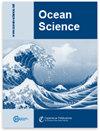Ocean color algorithm for the retrieval of the particle size distribution and carbon-based phytoplankton size classes using a two-component coated-sphere backscattering model
IF 3.3
3区 地球科学
Q2 METEOROLOGY & ATMOSPHERIC SCIENCES
引用次数: 1
Abstract
Abstract. The particle size distribution (PSD) of suspended particles in near-surface seawater is a key property linking biogeochemical and ecosystem characteristics with optical properties that affect ocean color remote sensing. Phytoplankton size affects their physiological characteristics and ecosystem and biogeochemical roles, e.g., in the biological carbon pump, which has an important role in the global carbon cycle and thus climate. It is thus important to develop capabilities for measurement and predictive understanding of the structure and function of oceanic ecosystems, including the PSD, phytoplankton size classes (PSCs), and phytoplankton functional types (PFTs). Here, we present an ocean color satellite algorithm for the retrieval of the parameters of an assumed power-law PSD. The forward optical model considers two distinct particle populations: phytoplankton and non-algal particles (NAPs). Phytoplankton are modeled as coated spheres following the Equivalent Algal Populations (EAP) framework, and NAPs are modeled as homogeneous spheres. The forward model uses Mie and Aden–Kerker scattering computations, for homogeneous and coated spheres, respectively, to model the total particulate spectral backscattering coefficient as the sum of phytoplankton and NAP backscattering. The PSD retrieval is achieved via spectral angle mapping (SAM), which uses backscattering end-members created by the forward model. The PSD is used to retrieve size-partitioned absolute and fractional phytoplankton carbon concentrations (i.e., carbon-based PSCs), as well as particulate organic carbon (POC), using allometric coefficients. This model formulation also allows the estimation of chlorophyll a concentration via the retrieved PSD, as well as percent of backscattering due to NAPs vs. phytoplankton. The PSD algorithm is operationally applied to the merged Ocean Colour Climate Change Initiative (OC-CCI) v5.0 ocean color data set. Results of an initial validation effort are also presented using PSD, POC, and picophytoplankton carbon in situ measurements. Validation results indicate the need for an empirical tuning for the absolute phytoplankton carbon concentrations; however these results and comparison with other phytoplankton carbon algorithms are ambiguous as to the need for the tuning. The latter finding illustrates the continued need for high-quality, consistent, large global data sets of PSD, phytoplankton carbon, and related variables to facilitate future algorithm improvements.基于双组分涂层球后向散射模型的海洋颜色粒度分布和碳基浮游植物粒度分类检索算法
摘要近地表海水悬浮粒子的粒径分布(PSD)是连接生物地球化学和生态系统特征与影响海洋颜色遥感的光学特性的关键属性。浮游植物的大小影响其生理特性以及生态系统和生物地球化学作用,例如在生物碳泵中的作用,生物碳泵在全球碳循环和气候中具有重要作用。因此,重要的是发展海洋生态系统的结构和功能的测量和预测能力,包括PSD、浮游植物大小类别(PSCs)和浮游植物功能类型(pft)。在这里,我们提出了一种海洋色卫星算法,用于检索假设的幂律PSD的参数。前向光学模型考虑了两个不同的粒子群:浮游植物和非藻类粒子(nap)。按照等效藻类种群(EAP)框架,浮游植物被建模为包被球体,nap被建模为均质球体。正演模型分别对均匀球和包覆球采用Mie散射和Aden-Kerker散射计算,将总颗粒光谱后向散射系数模拟为浮游植物和NAP后向散射的总和。利用正演模型产生的后向散射端元,通过光谱角映射(SAM)实现PSD检索。利用异速生长系数,PSD可提取按粒径划分的绝对和分数浮游植物碳浓度(即碳基PSCs),以及颗粒有机碳(POC)。该模型公式还允许通过检索到的PSD估计叶绿素a浓度,以及由于nap与浮游植物引起的后向散射的百分比。将PSD算法应用于合并的海洋颜色气候变化倡议(OC-CCI) v5.0海洋颜色数据集。初步验证工作的结果也提出了使用PSD, POC和浮游植物碳原位测量。验证结果表明,需要对浮游植物绝对碳浓度进行经验调整;然而,这些结果和与其他浮游植物碳算法的比较在需要调谐方面是模糊的。后一项发现表明,持续需要高质量、一致的大型全球PSD、浮游植物碳和相关变量数据集,以促进未来算法的改进。
本文章由计算机程序翻译,如有差异,请以英文原文为准。
求助全文
约1分钟内获得全文
求助全文
来源期刊

Ocean Science
地学-海洋学
CiteScore
5.90
自引率
6.20%
发文量
78
审稿时长
6-12 weeks
期刊介绍:
Ocean Science (OS) is a not-for-profit international open-access scientific journal dedicated to the publication and discussion of research articles, short communications, and review papers on all aspects of ocean science: experimental, theoretical, and laboratory. The primary objective is to publish a very high-quality scientific journal with free Internet-based access for researchers and other interested people throughout the world.
Electronic submission of articles is used to keep publication costs to a minimum. The costs will be covered by a moderate per-page charge paid by the authors. The peer-review process also makes use of the Internet. It includes an 8-week online discussion period with the original submitted manuscript and all comments. If accepted, the final revised paper will be published online.
Ocean Science covers the following fields: ocean physics (i.e. ocean structure, circulation, tides, and internal waves); ocean chemistry; biological oceanography; air–sea interactions; ocean models – physical, chemical, biological, and biochemical; coastal and shelf edge processes; paleooceanography.
 求助内容:
求助内容: 应助结果提醒方式:
应助结果提醒方式:


